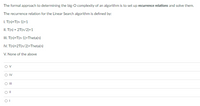
Database System Concepts
7th Edition
ISBN: 9780078022159
Author: Abraham Silberschatz Professor, Henry F. Korth, S. Sudarshan
Publisher: McGraw-Hill Education
expand_more
expand_more
format_list_bulleted
Concept explainers
Question
thumb_up100%

Transcribed Image Text:The formal approach to determining the big-O complexity of an algorithm is to set up recurrence relations and solve them.
The recurrence relation for the Linear Search algorithm is defined by:
I. T(n)=T(n-1)+1
II. T(n) = 2T(n/2)+1
II. T(n)=T(n-1)+Theta(n)
IV. T(n)=2T(n/2)+Theta(n)
V. None of the above
Ov
OII

Transcribed Image Text:Suppose we need to write an efficient program to store N employee records for ABC Inc where each employee record is identified by unique employee id. Consider the following ways to store the records.
1. An array list sorted by employee id
2. A linked list sorted by employee id
3. A linked list not sorted
4. A balanced binary search tree with employee id as key
For data structure above in 1-4, what is the average time to fınd an employee record given employee id as a key?
A. O(log N), O(log N), O(N), O(1)
B. O(log N), O(N), O(N), O(log N)
C. O(N), O(log N). O(N), O(1)
D. O(log N), O(log N), O(N), O(log N)
E. O(log N), O(log N), O(log N), O(1)
O A
O D
O E
O B
Expert Solution
This question has been solved!
Explore an expertly crafted, step-by-step solution for a thorough understanding of key concepts.
This is a popular solution
Trending nowThis is a popular solution!
Step by stepSolved in 3 steps

Knowledge Booster
Learn more about
Need a deep-dive on the concept behind this application? Look no further. Learn more about this topic, computer-science and related others by exploring similar questions and additional content below.Similar questions
- Code req positive integer decompose, find an algorithm to find the number ofnon-negative number division, or decomposition. The complexity is O(n^2). Example 1:Input: 4Output: 5Explaination:4=44=3+14=2+24=2+1+14=1+1+1+1 Example :Input: 7Output: 15Explaination:7=77=6+17=5+27=5+1+17=4+37=4+2+17=4+1+1+17=3+3+17=3+2+27=3+2+1+17=3+1+1+1+17=2+2+2+17=2+2+1+1+17=2+1+1+1+1+17=1+1+1+1+1+1+1.arrow_forwardSuppose you have an algorithm that operates on a set of data with n elements. If the recurrence formula that computes the time requirement for the algorithm is given by T(n) = 87 (C (1) + Dn a. nlgn b. n² lg n c. n² d. n³ e. if n > 1 if n = 1 where D and C are constants, which of the following gives the order of complexity of the algorithm? none of the other answersarrow_forward1. Determine the running time of the following algorithm. Write summations to represent loops and solve using bounding. Be sure to show work on both the upper bound and lower bound, justify the split, and check that the bounds differ by only a constant factor. Use asymptotic notation to write the answer. Func1(n) 1 2 3 4 5 6 7 8 9 10 11 S← 0; for i ←n to n² do for j← 1 to i do for k9n to 10n² do for mi to k end end end return (s); end s+s + i- j + k −m;arrow_forward
- Solving recurrences using the Substitution method. Give asymptotic upper and lower bounds for T(n) in each of the following recurrences. Solve using the substitution method. Assume that T(n) is constant n ≤ 2. Make your bounds as tight as possible and justify your answers. Hint: You may use the recursion trees or Master method to make an initial guess and prove it through induction a. T(n) = 2T(n-1) + 1 b. T(n) = 8T(n/2) + n^3arrow_forwardTime comp.arrow_forwardConsider the following algorithm that uses a sorted list of n elements (alist). What is the worst case runtime of this algorithm? for each element in alist 1. ask the user for an input, call it value 2. search value in alist using binary search 3. if value exists in alist, print "successful" otherwise print "unsuccessful" Question options: a. O(log n) b. O(n) c. O(n log n) d. O(2^n) e. O(n^2) f. O(1)arrow_forward
- Solve the following recurrences using recursion tree method and write the asymptotic time-complexity. 1. T(n) = 3T (n/4) + n^22. T(n) = T (n/5) + T(4n/5) + n3. T(n) = 3T(n − 1) + n^4 4. T(n) = T (n/2) + n^2arrow_forwardConsider the following recursive algorithm, where // denotes integer division: 3//2 = 1, 5//2 = 2, etc. F(n):if n <= 1: returnF(n//2)for i from 0 to n for j from 0 to n//2 print(i+j) Let function T(n) denote the running time of this algorithm. Derive T(n) and prove its worst case timecomplexityarrow_forwardI was told the answer is (n lg n) but I am not sure.arrow_forward
- Use a recursion tree to determine a good asymptotic upper bound on the recurrence T(n)=4T(n/2+2)+n. Use the substitution method to verify your answer.arrow_forwardUse the recursion tree method to solve the following recurrence T(n) by finding the tightest function f(n) such that T(n) = O(f(n)). T(n) ≤ 4.T(n/3) +0(n³)arrow_forward
arrow_back_ios
arrow_forward_ios
Recommended textbooks for you
 Database System ConceptsComputer ScienceISBN:9780078022159Author:Abraham Silberschatz Professor, Henry F. Korth, S. SudarshanPublisher:McGraw-Hill Education
Database System ConceptsComputer ScienceISBN:9780078022159Author:Abraham Silberschatz Professor, Henry F. Korth, S. SudarshanPublisher:McGraw-Hill Education Starting Out with Python (4th Edition)Computer ScienceISBN:9780134444321Author:Tony GaddisPublisher:PEARSON
Starting Out with Python (4th Edition)Computer ScienceISBN:9780134444321Author:Tony GaddisPublisher:PEARSON Digital Fundamentals (11th Edition)Computer ScienceISBN:9780132737968Author:Thomas L. FloydPublisher:PEARSON
Digital Fundamentals (11th Edition)Computer ScienceISBN:9780132737968Author:Thomas L. FloydPublisher:PEARSON C How to Program (8th Edition)Computer ScienceISBN:9780133976892Author:Paul J. Deitel, Harvey DeitelPublisher:PEARSON
C How to Program (8th Edition)Computer ScienceISBN:9780133976892Author:Paul J. Deitel, Harvey DeitelPublisher:PEARSON Database Systems: Design, Implementation, & Manag...Computer ScienceISBN:9781337627900Author:Carlos Coronel, Steven MorrisPublisher:Cengage Learning
Database Systems: Design, Implementation, & Manag...Computer ScienceISBN:9781337627900Author:Carlos Coronel, Steven MorrisPublisher:Cengage Learning Programmable Logic ControllersComputer ScienceISBN:9780073373843Author:Frank D. PetruzellaPublisher:McGraw-Hill Education
Programmable Logic ControllersComputer ScienceISBN:9780073373843Author:Frank D. PetruzellaPublisher:McGraw-Hill Education

Database System Concepts
Computer Science
ISBN:9780078022159
Author:Abraham Silberschatz Professor, Henry F. Korth, S. Sudarshan
Publisher:McGraw-Hill Education

Starting Out with Python (4th Edition)
Computer Science
ISBN:9780134444321
Author:Tony Gaddis
Publisher:PEARSON

Digital Fundamentals (11th Edition)
Computer Science
ISBN:9780132737968
Author:Thomas L. Floyd
Publisher:PEARSON

C How to Program (8th Edition)
Computer Science
ISBN:9780133976892
Author:Paul J. Deitel, Harvey Deitel
Publisher:PEARSON

Database Systems: Design, Implementation, & Manag...
Computer Science
ISBN:9781337627900
Author:Carlos Coronel, Steven Morris
Publisher:Cengage Learning

Programmable Logic Controllers
Computer Science
ISBN:9780073373843
Author:Frank D. Petruzella
Publisher:McGraw-Hill Education